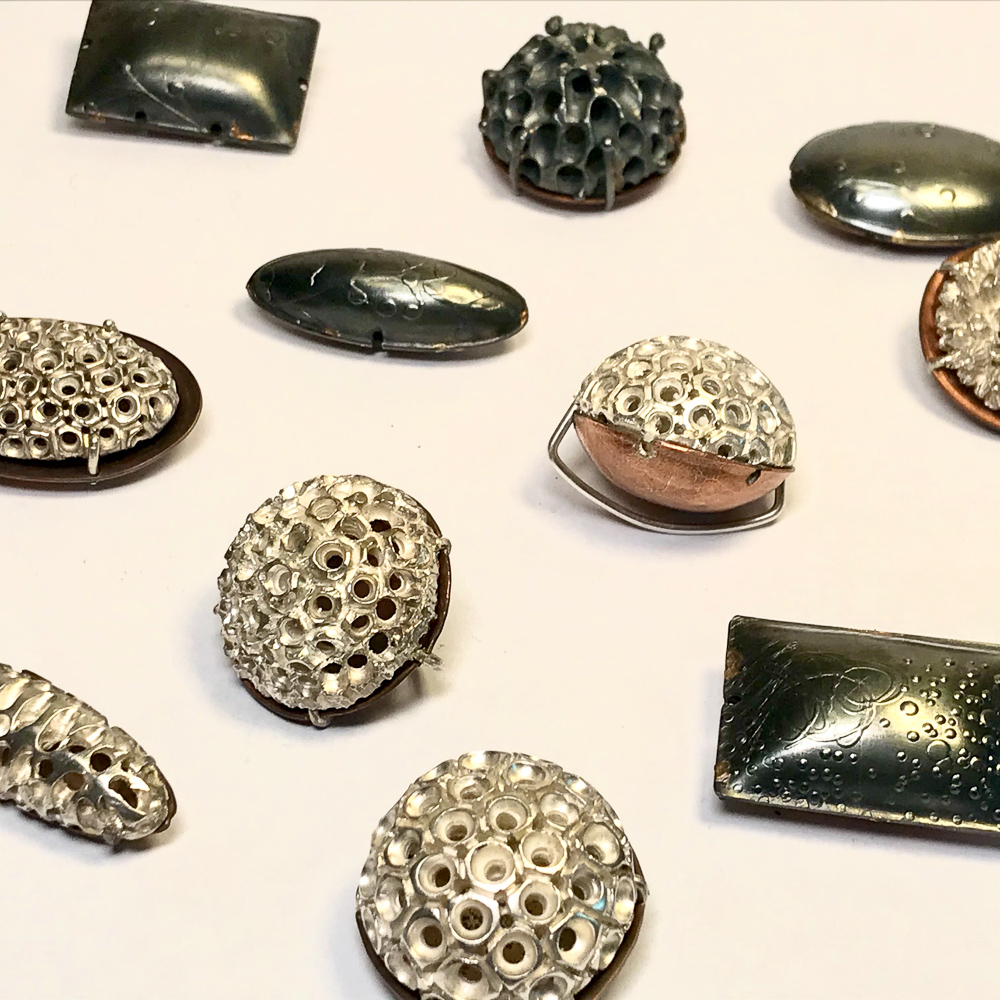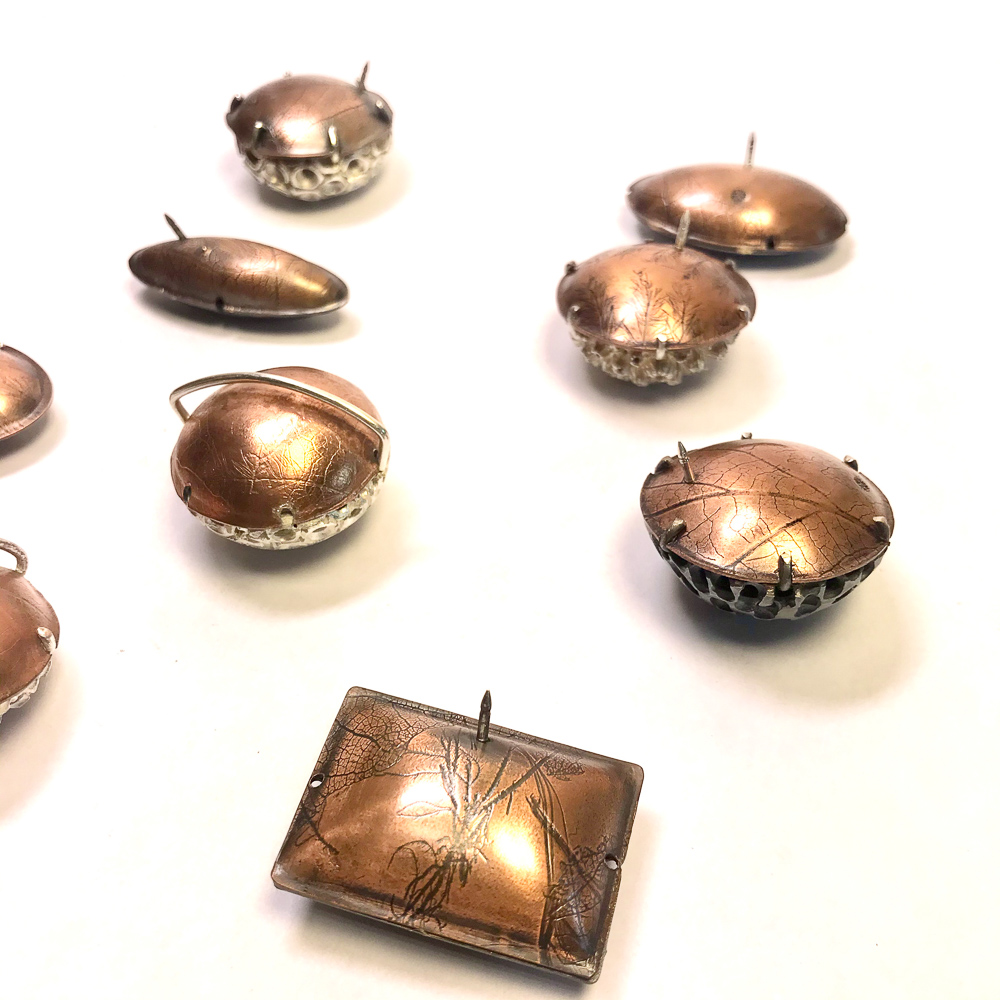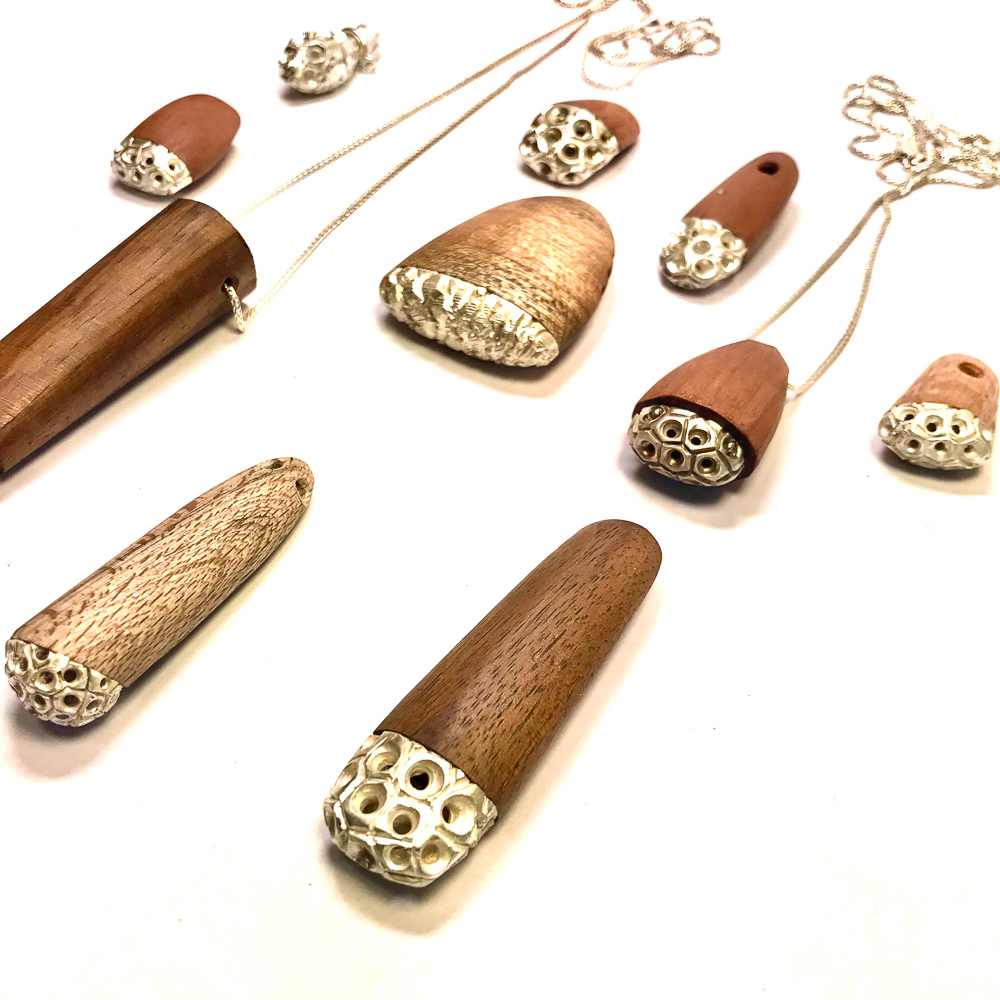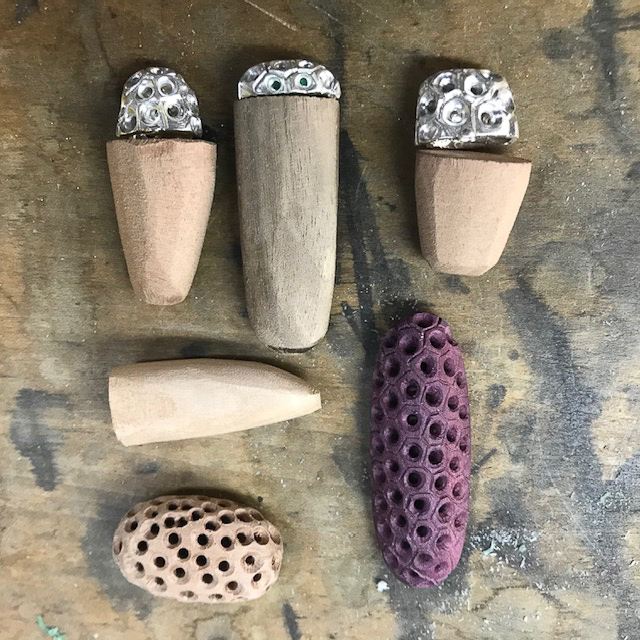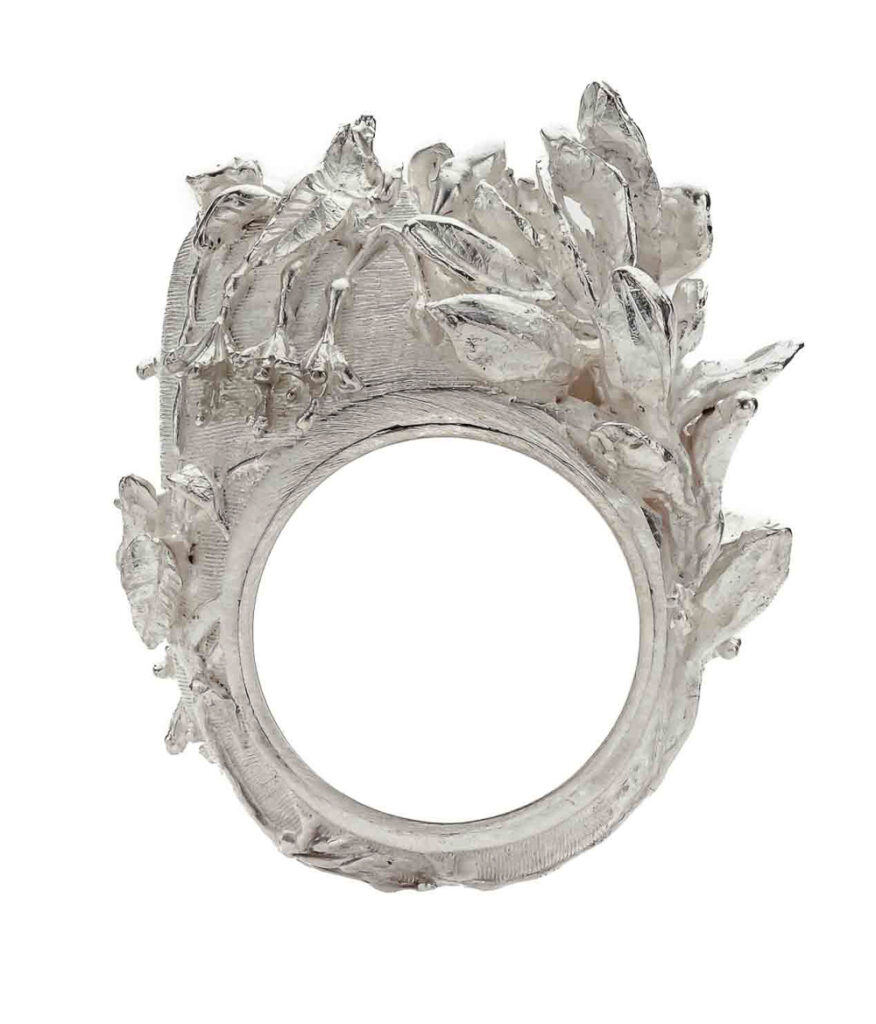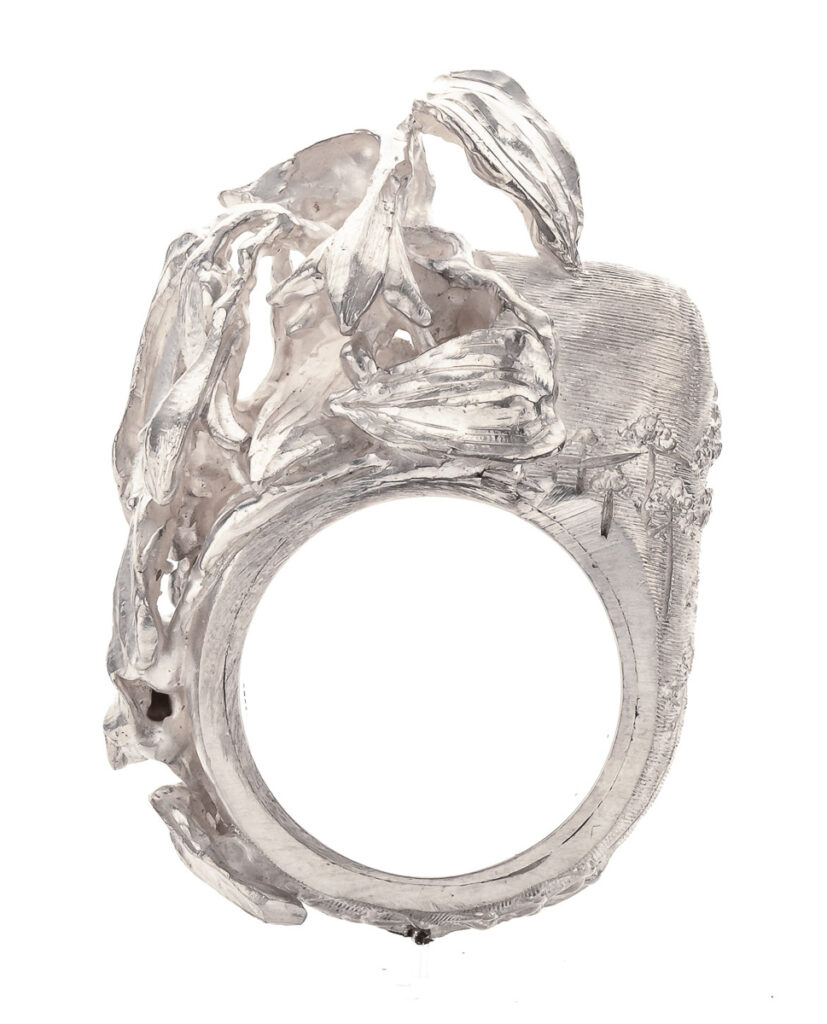
Artist in her studio, 2019, photo by Fran Razeto
Lucía Nieves Cortés shares a series of jewellery objects that activate a relationship between humans and plants in her adopted country.
(A message to the reader in Spanish.)
(A message to the reader in English.)
“As much as the copihue is unsuited for vases and bouquets, it is befitting for garlands, more than this, it is the natural garland par excellence devoid of thorny roses and unyielding jasmine.
[…] the copihue had the humour of being born and gifting itself only here, in the Chilean extremity, where the terrestrial globe shrinks […] I have attempted to present my Indigenous copihue in words, to shape it in words as a gift to whoever reads, and yet in the end I realise the uselessness of my effort. Nothing can be conferred in words, neither flowers nor exotic fruits […] and learning happens only though receiving, when in Puerto Rico they sang praises to the pomarrosa, the fragrant morsel did not enter my mouth, nor did it crack between my teeth. It is God’s will that every fruit and every flower be direct initiations. “To know them” requires to breathe them in and bite them,…”
Translated excerpt from Recado sobre el Copihue Chileno by Gabriela Mistral
In 2013 I moved from Berlin to Santiago de Chile, a change which I jokingly categorise as a move from one planet to another. I am originally from Puerto Rico, and have otherwise lived in The Netherlands and Mexico. In each of these places I lived at least one year and up to nine years, as was the case of Germany.
These were not just different places with different cultures, but also quite different climates, geographies and landscapes. Wherever I went, plants were there, in my peripheral view, but throughout my life they have gradually caught the centre of my attention.
Coming from a territory of eternal summer, the tropics, plants in these new places, so seemingly still, signalled the changes in seasons, a novelty for someone like me. If you look close enough, sharpen your eye, slow down your pace, they reveal themselves, not as mute as one would have thought. Despite having banished them to the fringe of our lives, these non-human people, as I have learned to see them, provide us with practically everything we need to survive and thrive. They are fantastic teachers, adapting to their context, in a relentless flow, and showing us their ways, if we would only pay them closer attention and begin to see them as our kin. Without them, we would have never been.
Each climate region presents quite different expressions of the vegetal. Perhaps this laid down the certainty that I could not continue making the same jewellery in Chile that I had been making in Germany. New place, new lessons to learn, new needs for adaptation and expression.
Thus, the Botanical Atlas of Chile in Jewellery stemmed from my own need for integration into a new geography and consequently a new plant landscape: an endeavour that could weave together my personal history of migrations, the relationship between humans and plants and my concerns about the environment.
Chilean flora has historically ignited the fascination of travellers and scientists. This land is considered a geographic island, cut off to the east not by sea but by the Andes mountains. Its unusual shape, a narrow strip that seems to be made up of north and south, but devoid of east or west, features an exhaustive catalogue of most sorts of imaginable climates, except, curiously enough, the one that I identify as my habitat: Chile has no tropical regions.
In the words of poet Gabriela Mistral:
“Geographers call the [southern forests] Trópico Frío (Cold tropics) and, although the nickname is contradictory, it corresponds to those truths that bear an absurd appearance: Chilean australity is wet and icy; but it resembles the tropics in its vicious vegetation and its mist of steams and aromas.”
Thus, a study of this, to me unknown, flora seemed as exotic and exciting as it could get for a native of the tropics. How can plants survive and thrive in the driest of all world regions, the Atacama Desert? Besides, “cold tropics”, what was that all about? It was clear that Chilean plants have a lot to teach us about endurance and adaptation.
For this voyage, a series of semantic shifts had to take place. In Chile, the botanical studies that laid the foundations for the discipline were carried out during the eighteenth and nineteenth centuries by white European men, through the lens of science, such as the illustrious Claudio Gay, founder of the Herbarium that later became Chile´s National Museum of Natural History. This “official history” turns a blind eye towards the ancestral botanical disciplines of First Nations Peoples, a wealth of knowledge accumulated across millennia.
How is an approach to the plant kingdom affected when we find ourselves in the twenty-first century seen through the eyes of a Caribbean mulata craftswoman? Could these shifts provide us with clues that might shed light on the labyrinth in which we find ourselves, a knot in which we are continuously pressured to adapt to environmental dangers, the menace of extractivist economies, social injustice and an accelerated impoverishment of so many areas of life, despite growing material wealth.
How does that pour over into the practice of the objects we make? What happens to an atlas, broadly interpreted as a functional view of our surrounding world, when a shift is made from a collection of images presented in book form to a collection of craft objects that attempts to describe realities, while simultaneously leading us into new territories? I felt the need to search for repair through integration of disciplines, times, spaces, views and beings in order to answer these concerns.
This journey led me to a lot of researching and questioning how we view ourselves in the face of the vegetal, even further, Nature writ large. The mission became fertile ground in an attempt to close the gaps between art, craft, science, ancestral knowledge, ethics and history. From early on I had the notion that the jewellery results of the project were a part of something greater.
This project is meant to become an opportunity for learning and then a tool to transmit the acquired knowledge, through objects and their process of becoming and the many branches of thought that they have elicited. I engaged the partnership of artist Maria Jose Rojas, whose own work reflects sensibly about the vegetal. Her guidance has proven essential to the development of this Atlas.
Semilloids
- Lucía Nieves, semilloids, 2019, copper, silver, variable dimensions, photo by Lucia Nieves
- Lucía Nieves, semilloids, 2019, copper, silver, variable dimensions, photo by Lucia Nieves
- Lucía Nieves, semilloids backs, 2019, copper, silver, variable dimensions, photo by Lucia Nieves
- Lucía Nieves, semilloids, 2019, Chilean native woods, silver, variable dimensions, photo by Lucia Nieves
- Lucía Nieves, semilloids, 2019, Chilean native woods, silver, variable dimensions, photo by Lucia Nieves
After much sketching, reading and many conversations, objects had to be made.
At the bench, when I still was unsure where the voyage should begin, I gave my hands a chance to warm up in the technique I proposed to work with, lost wax. I thought out a simple methodology of hexagonal geometries of perforations and cuts, which reminded me of natural patterns and traditional jewellery making, such as the geometries of pavé setting.
Variations blossomed in different expressions of what I call the semilloids. These pieces do not represent specific species, but have a basic character which speaks about organic forms and life. They are reminiscent of seeds, marine life, flowers, microscopic beings. Their unspecificity and open aspect are crucial to their being. The seed becomes a metaphor of enormous potential for life and capacity of transformation. It is a starting point with the possibility of branching out in innumerable directions, each branch is an imagined path, a stroll down a universe. The semilloid is a capsule of creative and regenerative potential that contains vast and archaic energy. An energy so powerful and generous, capable of healing and gifting the spectator with the possibility of growth in any which direction that she or he can imagine.
Alliances
- Lucía Nieves, Botanical Alliances, 2019,silver, ca.300 x 50 mm, photo by Fran Razeto
- Lucía Nieves, Foye-Chilco, 2019, silver, ca.300×50 mm, photo by Fran Razeto
- Lucía Nieves, side view of Botanical Alliances, 2019, silver, ca.300 x 50mm, photo by Fran Razeto
- Lucía Nieves, Pewen-Copiu, 2019, silver, ca.300×50 mm, photo by Fran Razeto
The Botanical Alliances is a series of five cast rings, each pairs two species of endemic plants from various Chilean habitats: Pewén-Copiu, the Araucaria, sacred tree of the Mapuche people, and the Copihue vine, so beautifully described by Mistral; Foye-Chilco, southern plants of great beauty and spiritual significance; Puya-Coquimbana to describe Chile´s dry and rocky landscapes; Quila-Pangue, resistant plants of great use for object making as well as sustenance the; and Palito-Culcul, ancient fern species which speak about some of the oldest plant life on Earth. I chose the species intuitively after studying the morphology and origin of plants through drawings. I relied on my outsider eye to choose those which stood out as beings of cultural or biological importance. Not only do the rings seal a pact between two plants, but with the wearer as well, embracing the body in a bond of reciprocity with nature. For this group I carefully carved and modelled wax into large format and sculptural pieces. Their dimension is noticeable and I worked the surfaces in great detail. I expect this series of five to expand and include more species, as well as to extend the idea to further atlases describing other botanical territories.
Balangandá
- Lucía Nieves, Balanganda Botánica, 2019, various Chilean native woods, silver, copper, steel, silk 120 x 190, photo by Fran Razeto
- Lucía Nieves, Balanganda Botánica, 2019, various woods, silver, copper, steel, silk 120 x 190, photo by Fran Razeto
The penca de balanganda is based on a jewellery typology originating in Salvador de Bahia, Brasil, akin to today´s charm necklace or bracelet: a central piece from which all sorts of pendants with a symbolic and talismanic power are added. They were worn by enslaved black women during the late nineteenth and early twentieth century.
A penca represents the meeting of cultures between Africa and America, the spiritual needs and the desires of abundance and prosperity of the women who carried them. I was attracted to this typology because it frequently featured botanical motifs and it seemed to span a bridge between jewellery, my own history and heritage and the subject of my project: expressions related to displaced or out-of-place women and the power of jewellery and plants to create a new connection to place, and express our innermost wants.
The Balangandá Botánica reinterprets this typology. Its cluster-like character was ideal to unite the techniques that I worked with throughout the project in an experimental way. I integrated the semilloids and applied their geometry to wood, working with native woods that I receive from other craft-making colleagues. This piece works as a remix of accumulated knowledge and picks up the concept of open possibilities by its additive character, a folding together of time, place and stories.
“But let us go back to the absolute “here” of the plant. There is nothing more difficult for us than to linger patiently in the “here,” without as much as fantasizing about something that lies “over there”, where we are not. Heidegger, for his part, understood human existence precisely as the possibility of “being-there” (i.e, not here, despite the literal translation of existence, or Da-sein). By implication, he deemed other living beings, tethered to the immanence of the “here” and to pure present, to be outside the sphere of existence, which hinges on a temporal stretching between the past of thrownness and the future of projection (Heidegger 1962). The plant’s relation to space—not to mention that of the animal—testifies to the problematic nature of this assumption.What we urgently need is an elaboration on the vegetal equivalent to the existential spatiality of Dasein; that is to say, a comparative analysis of our construction of, and interaction with, lived space and a parallel construction and interaction in the case of plants. How do plants make sense of the places they inhabit?”
Excerpt from The place of plants: spatiality, movement and growth, by Michael Marder.
Plants´sessile nature teaches us so much about how to be “here”. I wasn’t consciously aware of this when the journey began. Yet, in this “tethered here”, I have found a space that thrives on collaboration, integration and adaptation, where we have so much to learn, if we were humble enough, and maybe imagine other more vegetal futures.
✿
This project was made possible thanks to the generous support of the Ministry of Culture, Arts and Heritage of Chile through its national FONDART, funds for craft creation and production. The exhibition and publication of the project´s results are yet to be planned due to the adaptations imposed upon us by the COVID pandemic. You can follow further developments on www.instagram.com/atlasbotanicojoyeria. Finally, I am very honoured to announce that the Alianzas Botánicas ring series has been awarded the Sello de Excelencia a la Artesanía 2020, a recognition from the Chilean government that goes to 10 craftswomen and men each year.
Links
Gabriela Mistral, Recado sobre el Copihue Chileno
Michael Marder, The Place of Plants: Spatiality, Movement, Growth
Michael Marder, The Sense of Seeds, or Seminal Events
Further reading
Kimmerer, Robin Wall, Braiding Sweetgrass: Indigenous Wisdom, Scientific Knowledge and the Teachings of Plants. PENGUIN BOOKS, 2020.
Lazo, Waldo. Viajeros y botánicos En Chile Durante Los Siglos XVIII y XIX: 2010. Bicentenario De La Independencia De Chile. Editorial Universitaria, 2011.
Mancuso, Stefano, and López David Paradela. El Futuro Es Vegetal. Galaxia Gutenberg, 2017.
Moesbach, Ernesto Wilhelm de. Botánica indígena De Chile. Museo Chileno De Arte Precolombino, 1999.
Sagredo Baeza, Rafael. La ruta de los naturalistas. Las huellas de Gay, Domeyko y Philippi. Max Donoso Saint, 2012
Author
 Lucía Nieves Cortés is a puertorican artist and goldsmith currently based in Santiago de Chile. She studied goldsmithing and jewellery design at the Staatliche Zeichenakademie in Hanau, Germany and is a jewellery teacher at the Escuela Nacional de Artes Aplicadas in Santiago. Her studio work has been devoted to transmitting the values of joy and colour of her native tropics. She has lectured about the practice of jewellery making and wearing in Puerto Rico, Chile and Germany. The Botanical Alliances ring series, awarded with the Sello de Excelencia a la Artesanía 2020, are now part of the collection of the Museo de Artes Populares of Chile.
Lucía Nieves Cortés is a puertorican artist and goldsmith currently based in Santiago de Chile. She studied goldsmithing and jewellery design at the Staatliche Zeichenakademie in Hanau, Germany and is a jewellery teacher at the Escuela Nacional de Artes Aplicadas in Santiago. Her studio work has been devoted to transmitting the values of joy and colour of her native tropics. She has lectured about the practice of jewellery making and wearing in Puerto Rico, Chile and Germany. The Botanical Alliances ring series, awarded with the Sello de Excelencia a la Artesanía 2020, are now part of the collection of the Museo de Artes Populares of Chile.

